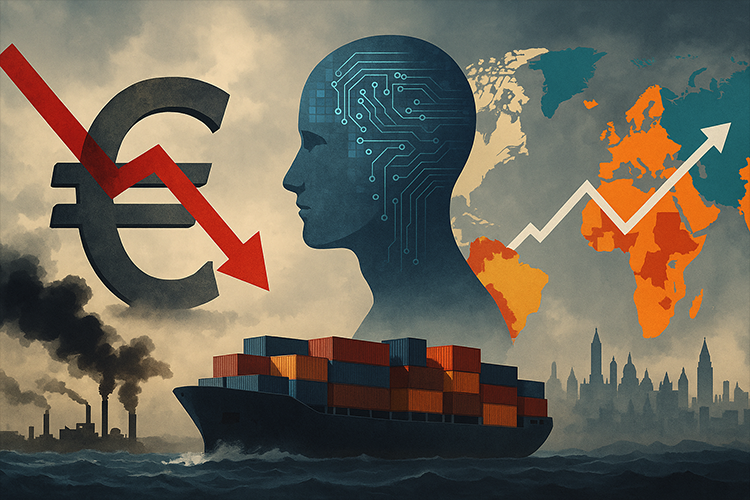Global Economy Faces Prolonged Disruption as Trade Tensions, AI and Climate Risks Reshape Growth
The global economy is entering one of its most turbulent periods in decades, according to the World Economic Forum’s latest Chief Economists’ Outlook (September 2025). Drawing on surveys of leading public and private-sector economists conducted between late July and mid-August, the report warns that weak growth, geoeconomic fragmentation, and technological disruption will define the coming year, with risks heavily skewed to the downside.
The IMF has revised its 2025 global GDP growth forecast slightly upward to 3%, compared with 2.8% in April, but this remains well below the long-term pre-pandemic average of 3.7% . A full 72% of chief economists surveyed expect global conditions to worsen in the year ahead.
Trade tensions are at the heart of the outlook. The United States has rolled out sweeping tariffs across a wide range of partners, pushing average tariff rates to levels not seen since the 1930s. The measures triggered supply-chain realignments, with UNCTAD reporting a $300 billion rise in trade volumes in H1 2025 as exporters rushed shipments ahead of further tariff changes. The US dollar, meanwhile, has depreciated by more than 10% since January—the steepest slide since 1973—granting emerging markets some monetary flexibility but also raising the cost of US imports.
Artificial intelligence is emerging as a second major disruptor. 68% of economists now expect AI to become commercially transformative within the next year, up from 45% just months earlier. OECD estimates suggest AI could boost G7 labour productivity growth by 0.2–1.3 percentage points annually over the next decade, but experts remain split on how the technology will reshape labour markets.
Regional dynamics are diverging sharply. The US outlook remains fragile despite a rebound to 3.3% GDP growth in Q2 2025, with tariffs, volatile inflation, and fiscal expansion weighing heavily. In Europe, growth slowed to just 0.2% in the EU and 0.1% in the euro area during the second quarter, though employment remains steady and inflation subdued at 2.1%, allowing the ECB to hold rates. China continues to post stronger numbers, with GDP up 5.2% year-on-year in Q2, but faces deflationary pressures as consumer prices slipped by 0.4% in August. Across East Asia and the Pacific, new US tariffs on Japan have already dragged exports down by 2.6% in July.
In emerging regions, prospects are mixed. Latin America and the Caribbean are projected by the World Bank to grow 2.3% in 2025, while Sub-Saharan Africa could expand 3.7%, rising above 4% by 2027, assuming stable conditions. The Middle East and North Africa currently show the strongest growth momentum, with forecasts of 2.7% in 2025 and over 4% by 2027, supported by energy diversification and investment partnerships. South Asia remains among the fastest-growing regions, with India projected at 6.4% GDP growth in 2025, though new US tariffs on exports pose headwinds.
Beneath these headline figures, the report emphasizes deeper structural changes. Trade fragmentation is likely to become long-lasting, locking in new supply-chain patterns. Climate shocks—from Iberian wildfires to deadly floods in Pakistan—have underscored the mounting economic toll, with OECD data showing weather disasters already shaving 0.3% off annual GDP on average between 2006 and 2018. Chief economists overwhelmingly expect climate and resource pressures to persist for decades.
At the institutional level, global economic governance is weakening. The United Nations and WTO face restructuring and diminished roles, while development aid is being cut back. Nearly 67% of economists expect this to widen the gap between advanced and developing economies, even as regions such as Sub-Saharan Africa and Latin America hold significant untapped growth potential.
The Forum concludes that advanced economies will rely increasingly on technology and human capital, while developing regions depend more heavily on capital flows and natural resources. Yet both face inhibitors—from political instability and weak institutions to trade barriers and fiscal vulnerabilities.
The report frames today’s turbulence as the transition to a “new global economic order.” While this environment carries elevated risks, it also offers opportunities for economies willing to adapt through investment in skills, innovation, and international cooperation.
Source: World Economic Forum








